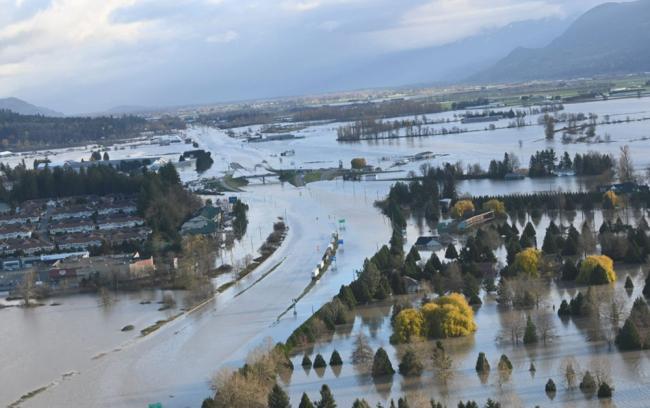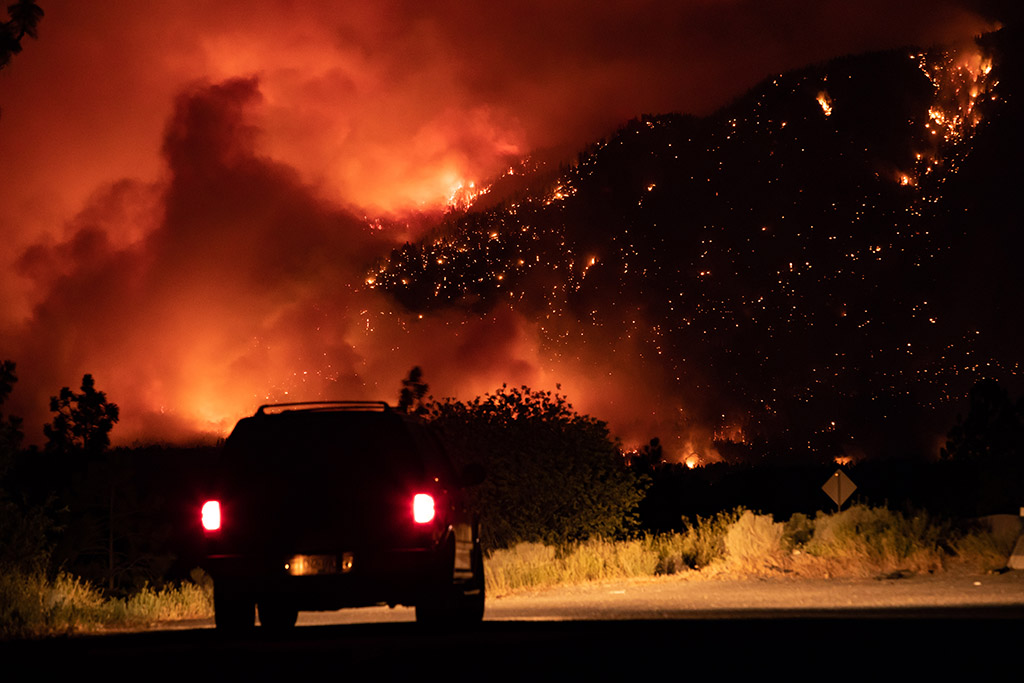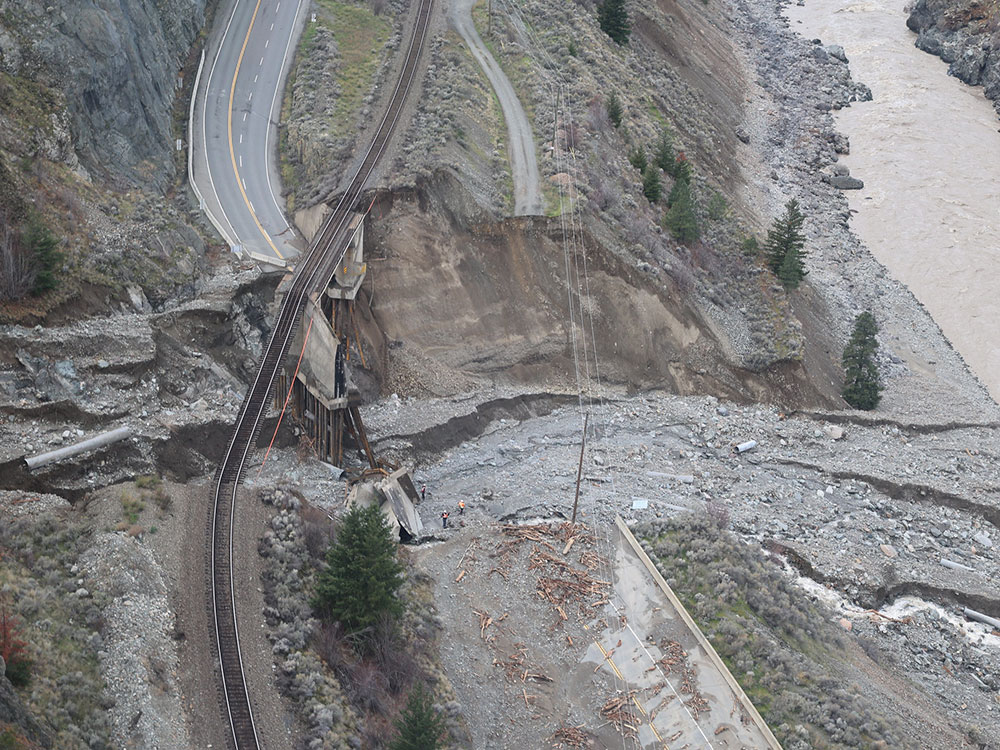Articles Menu

Nov. 30, 2022
When Don and Mary Nowoselski moved from Dawson Creek in northeast British Columbia to the Creston Valley 30 years ago, they were looking for a little less winter.
A bit of land tucked near the U.S. border in a fertile valley in the province’s East Kootenay region seemed to fit the bill, and the couple settled into a new life that included an expanding cherry orchard operation.
Small by local standards, their orchard eventually expanded to 23 acres and 14,000 trees. Over the years, the couple would experience their fair share of seasonal ups and downs — a preponderance of rain and cooler temperatures one year, or its opposite the next.
But nothing too extreme. Until the summer of 2021, that is.
The Nowoselskis were among tens of thousands of British Columbians to be scarred by last year’s heat dome.
Tens of thousands more would then be severely tested by the wildfires to follow.
And then there was the year-ending floods and landslides that left five dead on the Duffey Lake Road, thousands forced to flee their damaged or destroyed homes in Merritt and Princeton; police, fire, paramedic crews and volunteers scrambling to get people out of harm’s way; and thousands of businesses suddenly without supplies.
Singly, each of those three events exacted a heavy toll on the province. Collectively, they made for the single-worst climate catastrophe in Canadian history.
Two key questions arise from those interrelated events: Just how significant was the economic hit? And what, if anything, should we learn from 2021 as we look ahead to future extreme weather events, which climate scientists warn are likely to be more frequent and severe?
Estimating the full cost of a climate catastrophe, let alone multiple catastrophes, is not easy. In the immediate aftermath, the first and often only estimates are of insured damages to property. But insured damages are only the tip of the proverbial iceberg.
Our research, published today by the Canadian Centre for Policy Alternatives, shows that when the broad sweep of non-insured losses is considered — along with a number of other factors — the estimated economic hit in B.C. associated with 2021’s extreme weather events is in the range of $10.6 billion to $17.1 billion.
Our estimate includes:
One key takeaway from 2021’s extreme weather events is that in many ways, they were linked, with one making the other worse.
The community of Merritt, for example, turned out to be particularly vulnerable when November’s rains began because months earlier forests nearby were destroyed in intense wildfires.
As mid-November’s atmospheric river (a.k.a. “Pineapple Express”) weather pattern gathered force moving over the Coast Mountains, it dumped huge amounts of rain on those burned lands, which repelled rather than absorbed much of that water. Soon, the levels of the Coldwater River, which flows through the town, were “beyond extreme,” according to Allan Chapman, a professional hydrologist who independently examined last November’s flooding.
As the waters rose, they pushed up against dikes that were clearly insufficient to contain the river. The dikes broke, forcing the evacuation of Merritt’s 7,000 residents.
The estimate to fix the destroyed dikes, an uninsured loss, ranges between $165 million and $169 million — a staggering cost that is not feasible to pay, according to the town’s mayor.
“The city, on average, pulls in through taxes about $9.5 million annually. So when you throw in a number of $169 million, it’s virtually impossible for us to deal with,” says Merritt’s mayor, Mike Goetz.
So what do some of the other costs associated with 2021’s back-to-back extreme weather events look like? Here’s a roundup.
The 2021 heat dome was at its worst over four days in late June when temperature records were shattered. Temperatures reached over 40 C in many parts of the province, leading to 619 heat-related deaths across B.C.
The farming sector, in particular, was hammered by the heat. More than 650,000 chickens and other livestock animals died, while certain crops were either significantly damaged or destroyed altogether.
These losses also had a huge impact on fruit pickers and others who were paid hourly wages.
The Nowoselskis were among those orchardists who used a rotating crew of between 50 and 100 pickers who moved back and forth between orchards as different cherry varieties ripened. The better pickers were routinely earning $300 to $400 or more per day.
All of those people lost work, as did others working in outdoor settings and in indoor, non-air-conditioned settings.
We estimate that between $205 million and $328 million in income was lost in the most-affected sectors. Additionally, heat waves slow everyone down and therefore are also associated with general productivity declines. Over the four days of maximum temperatures, this likely cost the economy an additional $34 million to $84 million in lost productivity.
Another interesting gauge of the heat dome — one that highlights how climate change exacerbates inequalities — was seen in data released by BC Hydro.
The heat dome led to an all-time summer peak hourly demand for power on June 28, when British Columbians spent between $8 million to $14 million more on electricity, much of it to power air conditioners.
The summer and fall wildfires
The heat dome set the Canadian record land temperature in Lytton for three days in a row before a wildfire on the fourth day destroyed the town, causing $102 million in insured damages. The day before the June 30 fire, the heat in Lytton hit 49.6 C, breaking the Canadian record for highest-ever temperature.

Two weeks later, the White Rock Lake fire in the Okanagan destroyed the community of Monte Lake overnight, with insured damages estimated at $77 million for 800 properties.
Based on typical insurance industry coverage for wildfires, non-insured damages associated with just those two conflagrations would add another $179 million to $501 million to the tally.
Cumulatively, the fires and smoke prompted 181 evacuation orders, 304 evacuation alerts and displaced almost 33,000 people. We estimate the value of work time for those displaced people ranged from $33 million to $99 million in lost income.
The fires also severely disrupted supply chains. Canadian National and Canadian Pacific both saw their rail operations severely curtailed due to a blockage in the Fraser Canyon between June 30 and July 5 that stranded thousands of rail cars. Workers were also affected by supply-related closures created by backlogs of shipping containers through the Port of Vancouver.
These labour market impacts cost B.C.’s economy an estimated $281 million to $463 million due to work slowdowns in key affected sectors.
The costs of the public response to wildfires fall mainly on firefighting efforts. A record $801 million was spent on firefighting in 2021, an amount that dwarfs the $136 million allocated in the B.C. budget.
Isolated Indigenous communities like the Shackan Indian Band in the Nicola Valley were particularly at risk from the wildfires. Forced to evacuate its members during the wildfire season, the same community would later be evacuated during the November floods.
Those back-to-back evacuations hint at what could be a new significant future cost — the amount needed to purchase new reserve land in some other location that is less vulnerable to fires and floods.
“At the end of the day, I don’t want to have to sleep with one eye open or have to be running again,” Chief Arnie Lampreau says.
The wildfires also work against B.C.’s climate objectives. The pulse of carbon associated with the 2021 wildfires is equivalent to almost double the province’s official carbon emissions that year.
November’s floods and landslides
The heat and fires of summer 2021 shifted quickly to cooler, wetter weather in the fall. Some seven atmospheric rivers hit B.C., the largest one starting on Nov. 13, leaving behind a path of devastation.

Extensive damage to public infrastructure included the failure of dikes in the Fraser Valley, Merritt and Princeton areas, the closure of 24 highways at peak flooding, sections of highway destroyed by landslides — including on Highway 99 where five people were killed — five damaged bridges on the Coquihalla Highway and much more.
According to the provincial government, an additional $522 million was spent on disaster and emergency assistance related to the November floods. The most-recent provincial budget committed $400 million in 2022-23 and another $1.1 billion over three years in contingencies for flood recovery.
In addition, the federal government has promised up to $5 billion for flood relief.
As of June of this year, insured flood-related damages were reported at $675 million. But this number only scratches the surface. The insurance industry typically pays only about 12 cents per dollar of damage from overland flooding.
This implies there may be as much as $4.7 billion in non-insured, flood-related damages. Even if we assume that private insurance covered 30 per cent of total damages, non-insured damages would be approximately $1.5 billion.
Supply chain disruptions in the aftermath of the mid-November atmospheric river were legion. Private rail lines that serve as key transportation infrastructure for Canadian resource industries didn’t see a return to pre-flood productivity and capacity until Dec. 21, more than a month after the washouts.
The Trans Mountain pipeline, which connects the Lower Mainland to Alberta’s crude and refined fuels, was shut down during the immediate recovery period, leading Burnaby’s Parkland refinery to have down time between Nov. 22 and Dec. 15.
We estimate that labour market impacts arising from the flooding, based on known disruptions locally and supply chain impacts, ranged from $800 million to $1.4 billion. This is for B.C. workers only and not potential supply chain impacts outside the province. In addition, the flood-related displacement of 17,000 people translated to between $68 million and $153 million in lost income.
By far, the flooding was the worst of the three disasters, with costs that may exceed $7 billion. Taken together with the heat dome and wildfires, we estimate that the extreme weather events of 2021 cost between $10.6 billion and $17.1 billion.
An eye to the future
Whatever the final cost of the 2021 climate disasters, it is a large number. But the big question, by far, is: what lessons can we draw from that?
Our hope is that prompts governments to substantially increase climate action investments.
Senior levels of government must come to the aid of local communities that are both in harm’s way and that don’t have the economic means to fund the investments needed to safeguard their citizens.
This means simple things such as providing early and effective warnings to people so they have a chance to get out of harm’s way — something the provincial government was criticized for failing to do when November’s storms approached.
Caroline and Paul Mosterman had their blueberry farm, specialty nursery, a wine and spirit tasting room, heavy farm machinery and much more severely damaged by the flood on Sumas Prairie. Today, Caroline says, much of what the couple lost last November could have been saved had there been earlier and more effective warnings about the danger headed their way.
But those warnings were far too late, as detailed earlier in The Tyee.
“We could have moved mountains in two days,” Mosterman says. “A hill is less than five minutes away. Our friends could easily have accommodated our inventory — wine and spirits — equipment and machinery. That would have mitigated the damage considerably, easily in the hundreds of thousands of dollars.”
It also means facing up to the fact that billions of dollars must be spent to build higher and stronger dikes to deal with floodwaters — a massive investment required to better protect hundreds of B.C. communities, including many in the most populous region of the province, the Lower Mainland.
And, hundreds of millions of dollars must be found to assist communities to thin and do prescribed burns in the forests that surround them so they are less susceptible to being overrun by uncontrollable wildfires.
What frustrates wildland fire ecologist Bob Gray more than anything is to hear 2021 described as a “wake-up call” for the province. The fires that burned in B.C. in the back-to-back record-setting years of 2017 and 2018 were even worse than 2021, Gray points out.
He believes those events have led to “unprecedented levels of public anger, frustration and distrust toward the forest industry and government institutions.”
The way to regain that trust is to start funding the work that is needed to reduce future risks.
We are beginning to appreciate what was lost in the climate disasters of 2021. The public policy priority now must be to commit the funds to reduce the likelihood of such severe events in the future.
Marc Lee is a senior economist with the Canadian Centre for Policy Alternatives. Ben Parfitt is a resource policy analyst with the CCPA’s B.C. office.
[Top photo: Climate-related disasters like 2021 flooding in the Fraser Valley will take an increasing economic and human toll. Photo via City of Abbotsford.]